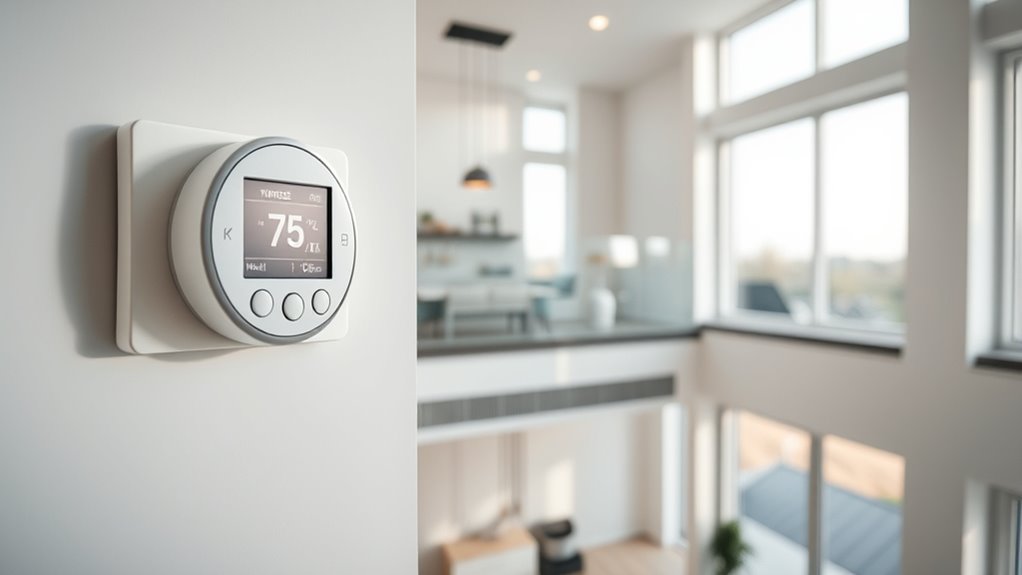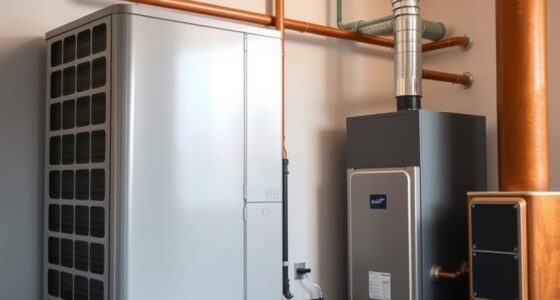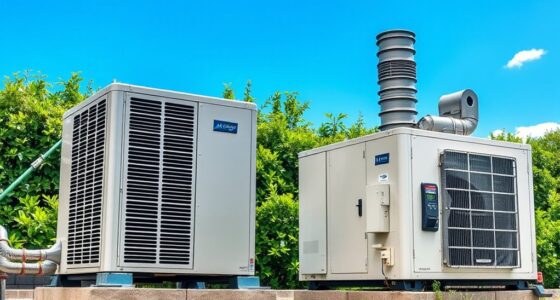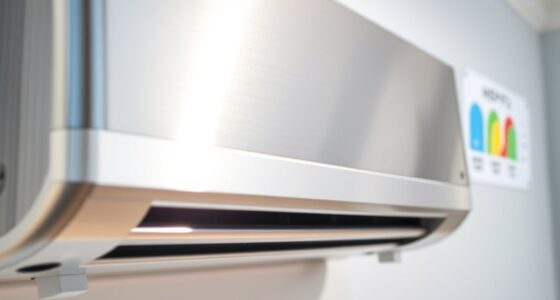Zone-based HVAC control improves your multi-story home’s comfort by allowing you to set different temperatures for each area. It helps prevent hot or cold spots, making every room more comfortable. You can save energy and lower bills by adjusting heating or cooling in unoccupied zones. Plus, it offers better control, supports demand response programs, and extends your system’s lifespan. Keep exploring to discover how these benefits can make your home more efficient and cozy.
Key Takeaways
- Provides precise temperature control for different rooms or zones, enhancing overall comfort in multi-story homes.
- Increases energy efficiency by allowing heating and cooling only where needed, reducing utility costs.
- Supports participation in demand response programs, helping to lower peak energy usage and utility bills.
- Offers flexible control via smart technology, enabling remote adjustments for optimal climate management.
- Extends HVAC system lifespan by reducing strain and wear through targeted, efficient operation.
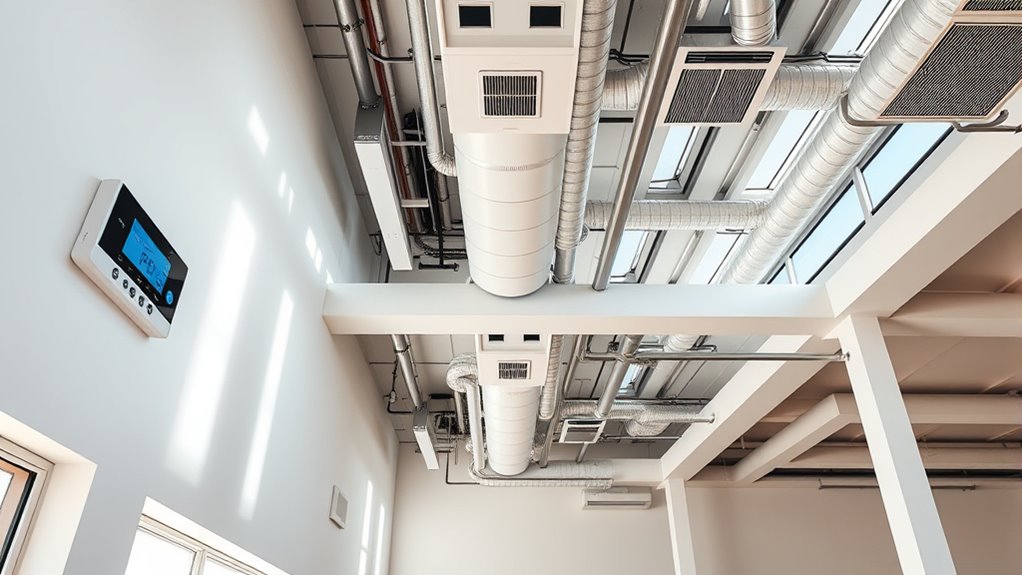
Managing heating and cooling in multi-story homes can be challenging because different floors often have varying temperature needs. You might notice that the upper levels tend to be warmer in summer or cooler in winter, making it hard to maintain a consistent comfort level throughout the house. That’s where zone-based HVAC control shines. By dividing your home into separate zones, you gain precise control over each area’s temperature, allowing you to customize settings based on specific needs rather than applying a blanket setting across the entire house. This targeted approach not only enhances comfort but also helps you optimize energy use.
One notable benefit of zone-based systems is their ability to participate in demand response programs. During peak energy usage periods, utility providers often encourage consumers to reduce power consumption to prevent grid overloads. With a zone-based HVAC system, you can automatically adjust or limit heating and cooling in certain zones when demand response signals are received. This flexibility helps you contribute to a more stable grid while potentially earning incentives or lower rates from your utility company. It’s a smart way to be environmentally conscious and financially savvy at the same time.
Zone HVAC systems support demand response programs, helping you save energy and money during peak periods.
Moreover, zone control offers substantial energy savings. When you can turn down or shut off heating or cooling in unoccupied or less-used areas, you avoid wasting energy on spaces that don’t need it. For example, if you’re sleeping in the master bedroom and the kids are in a different part of the house, you can set the system to prioritize comfort where it’s needed most. Over time, these adjustments considerably reduce your utility bills. Plus, because each zone is managed independently, the HVAC system doesn’t have to work as hard to maintain desired temperatures, extending its lifespan and reducing maintenance costs.
Another advantage is that zone-based systems provide greater flexibility, especially for multi-story homes with complex layouts. You can set different temperatures for each floor or even individual rooms, catering to personal preferences or specific activities. This level of customization creates a more comfortable environment while maximizing efficiency. Additionally, modern zone controls often come with smart technology integration, allowing you to control settings remotely via smartphone apps. This means you can adapt your home’s climate even when you’re away, ensuring comfort and further energy savings. Proper zoning also helps prevent hot or cold spots, improving overall comfort.
Frequently Asked Questions
How Much Does Zone-Based HVAC Control Installation Typically Cost?
The cost considerations for zone-based HVAC control installation typically range from $2,000 to $5,000, depending on your home’s size and complexity. Installation expenses can vary based on the number of zones and the system’s brand. You should budget for professional setup to guarantee peak performance. While it’s an upfront investment, the energy savings and improved comfort often justify the expense over time.
Can Existing HVAC Systems Be Upgraded to Zone Control?
Certainly, you can easily upgrade your existing HVAC system to incorporate duct zoning. By installing a smart thermostat and zoning dampers, you can transform your current setup into a tailored, temperature-tuned system. This upgrade allows you to target specific areas, save energy, and improve comfort. With straightforward modifications, your home becomes smarter and more efficient, making zoning a wise and workable upgrade.
What Maintenance Is Required for Zone-Based HVAC Systems?
You’ll need to regularly replace filters and calibrate sensors to keep your zone-based HVAC system running smoothly. Check filters every 1-3 months and change them as needed to maintain airflow and efficiency. Sensor calibration should be performed annually to ensure accurate zone temperature readings. Additionally, keep an eye on ductwork and control panels for dust or issues, and schedule professional inspections to prevent problems and optimize performance.
How Long Does It Take to Install a Zone Control System?
Installing a zone control system typically takes about a day or two if you’re doing a DIY installation and have some HVAC experience. The process depends on your system’s compatibility, so verify your current HVAC setup supports zone controls. If your system is compatible, you can save time and money. However, for complex setups or unfamiliar systems, it’s best to consult a professional to ensure proper installation and performance.
Are There Specific Brands or Models Recommended for Multi-Story Homes?
Are you wondering which brands excel for multi-story homes? Consider systems like Honeywell, Ecobee, or Nest, known for their reliable smart thermostats and zoning dampers. These brands offer advanced features, easy integration, and proven performance. Do you want to maximize comfort and efficiency? Choosing reputable models guarantees seamless control across multiple zones, helping you tailor heating and cooling precisely where you need it most.
Conclusion
By implementing zone-based HVAC control, you’ll enjoy tailored comfort and energy savings throughout your multi-story home. It’s no coincidence that homeowners who adopt zoning often notice lower utility bills and increased convenience. When each area controls its temperature independently, you’re more in control of your comfort—and your energy use—without sacrificing efficiency. Ultimately, zoning isn’t just a smart choice; it’s the natural way to make your home more comfortable and cost-effective.
